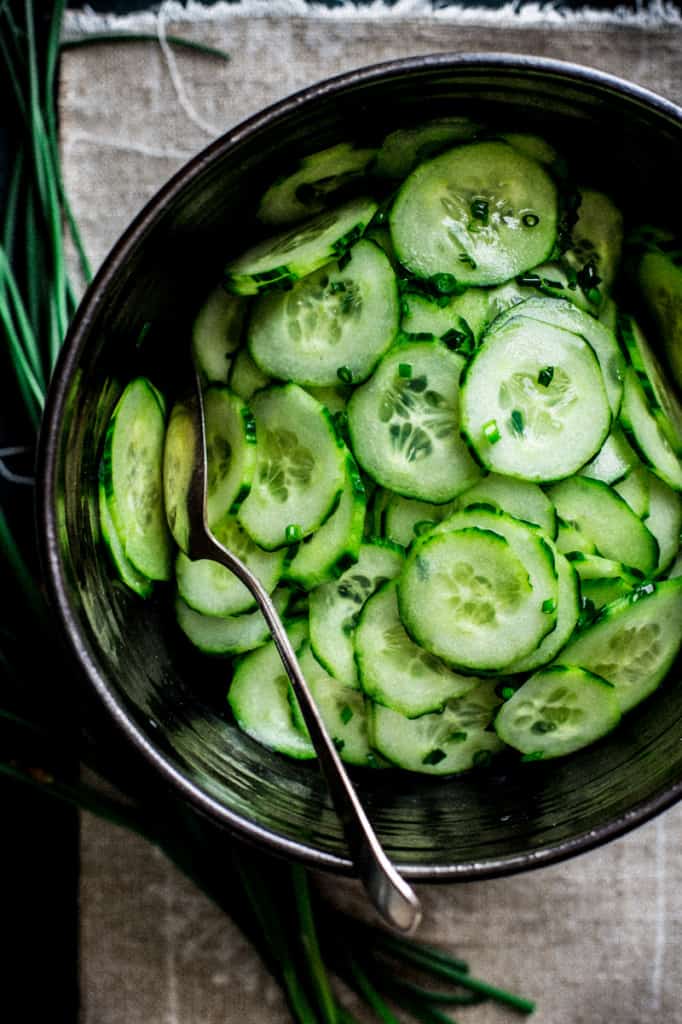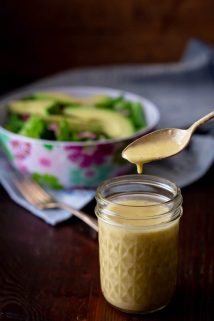Guide To Vinegar
Have you wondered what is the difference between all the different vinegars? There are so may to choose from, which is healthiest? Which one tastes best in my recipe? Here is my ultimate guide to vinegar, with explanation of seven different kinds. I always have them in my cabinet, and I will explain why each is important, and my favorite uses of each one.

Table of contents
One of the things I have been excited to do is to start talking about building a healthy pantry. So today I want to do just that and focus specifically on vinegar. Really? A whole post just about vinegar? Yes indeedee! Okay, go ahead and roll your eyes, but I am a total vinegar lover, and I actually have a cabinet next to my stove with two shelves. One is all vinegar and the other is all oil. And I use all of them!

Just stand in the vinegar isle at the supermarket, and it can be overwhelming. Which vinegar do I buy? For starters, I think you should have all of these seven vinegars listed below. And maybe even a few more that I haven’t. These are all very different.
How Vinegar is Made
Besides being sour, what they all have in common is that they are all derived by the fermentation process.
The starting liquid can be anything from wine to apple cider (as long as there are sugars present.) Just like in the fermentation process of making beer or wine, the sugars in the starting liquid or juice are broken down by bacteria and yeast.
That produces alcohol, and then eventually vinegar. Depending on the speed and technique for this fermentation process, and the liquid from which it starts, there are varying degrees of acidity and flavor in the end results.
Which Vinegar To Buy
Below you’ll find the seven vinegars I think you should consider buying for your healthy pantry.
I have included notes on acidity and uses. I also added in a note about seasonality too. This has more to do with the types of food these vinegars work with best (not about availability.) I also linked to a featured recipe for each.

Sherry Vinegar:
ACIDITY: 7.5% acidity
CHARACTERISTICS AND USES: This is very sour and really strong coming in at the most acidic of all. It needs to be used in moderation. It has a strong oaky, caramely and somewhat smoky flavor. I love to pair it with strong greens and big flavors.
I particularly love it with honey and paprika. I add a touch to sautéed greens or a splash into vegetable soups in the fall.
It pairs beautifully with maple in Maple Sherry Vinaigrette. Buy it at good grocery stores, gourmet stores and health food stores.
SEASONALITY: Fall and winter
FEATURED RECIPE: Beet Green Salad with Feta and Sherry Vinegar

White Wine Vinegar:
ACIDITY: 6% acidity
CHARACTERISTICS AND USES: Made from white wine, this is probably my favorite vinegar of all. I love using it with shallots and herbs in a salad dressing like in this yogurt dill dressing or added into recipes with a creamy dairy element. The bright acidity pairs well without competing with the flavors. It is really clean and bright and quite tart. You’ll need to balance it with salt.
SEASONALITY: spring or summer
FEATURED RECIPE: Salad Nicoise Dressing

Balsamic Vinegar:
ACIDITY: 6% acidity
CHARACTERISTICS AND USES: When it comes to balsamic vinegar, you really get what you pay for. The less expensive grocery store balsamic vinegars are usually Balsamico Di Modena, a cheap imitation of traditional balsamic. They are often harsh and have added caramel to flavor and color it (and sometimes thickeners.)
With traditional Balsamic vinegar, some bottles go for upwards of forty dollars, but they really are a thing of beauty.
Traditional Balsamic vinegar is made from reduced Trebbiano and Lambrusco wines. It is aged for varying lengths of time, usually a minimum of 12 years, and the longer it ages, and the more it evaporates the more thick and complex it becomes.
There is a multi barrel process used for all of this, and it is steeped in tradition. This process, also happens to be how it gets more and more expensive.
Pair good balsamic with naturally sweet produce like tomatoes or fresh green beans with balsamic and walnuts, or try drizzling really good aged balsamic vinegar over fresh strawberries.
I like to drizzle it over sheet pan chicken for an easy “sauce.” Use less expensive varieties to enhance cooked vegetables and bring out their natural sweetness.
SEASONALITY: Fall, year round
FEATURED RECIPE: Balsamic Kale with Cranberries

Distilled White Vinegar:
ACIDITY: 5% acidity
CHARACTERISTICS AND USES: This is made from a base made of grain and/or corn, and frankly has a harshness to it that is only appropriate in some recipes. It has no flavor other than sour. For that reason I don’t use it very often.
I usually have a large jug of this under my sink for cleaning around the house. And a smaller organic bottle in my pantry. I like to use it with strong flavors, particularly Asian inspired seasonings.
It’s neutrality also makes it great for pickling. I usually add some sort of sweetener too to balance it out. Note: if you are strictly gluten free or are cooking for someone who is gluten free, you may want to avoid this type of vinegar.
SEASONALITY: Late winter, Spring, year-round
FEATURED RECIPE: Asian Coleslaw

Apple Cider Vinegar:
ACIDITY: 5 % acidity
CHARACTERISTICS AND USES: I wrote an entire post about this vinegar already. Here’s how it is made and how to use it in Apple Cider Vinegar Dressing.
As the name implies this is fermented from apple cider. Look for locally made cider vinegars or ones that have the mother of vinegar floating around in the bottle.
Avoid the clear ones that have been filtered. It has a natural sweetness that is great with cold weather food. It loves to hang out with pork, bacon, honey, sweet onions and cheddar.
SEASONALITY: Fall, Winter
FEATURED RECIPE: Sweet Potato Cheddar Soup with Chipotle
Red Wine Vinegar:
ACIDITY: 5% acidity
CHARACTERISTICS AND USES: Fermented from red wine, this has a really nice range of uses and is one of the most versatile of all the vinegars. From Italian Pasta Salad to dressing for a simple Garden Salad, it is a chameleon in the world of vinegars!
It is a little sharper in flavor than white wine vinegar, even though technically it is usually lower in acidity. I love to add a splash of this to brighten up savory dishes and it is amazing in a marinade.
It can really amp up the flavor of a dish without adding any calories. Just be sure to balance it with a salty or savory element.
SEASONALITY: Summer, year-round
FEATURED RECIPE: Easy Maple Pickled Onions

Rice Wine Vinegar:
ACIDITY: 4.3% acidity
CHARACTERISTICS AND USES: This is a very mild vinegar and can be used in larger quantities without throwing a recipe out of wack.
I love to use it for a base for dipping sauce, like for dumplings or summer rolls. It can also be used for pickling link these Pickled Carrots. It is very mild in flavor and has natural sweetness.
Make sure you read the label before buying, some are seasoned. These have salt and sugar added.
SEASONALITY: summer
FEATURED RECIPE: Simple Skinny Cucumber Salad

Thank you so much for reading. If you find this resource helpful, please leave a comment below, and make sure to sign up for my mailing list!
















I am just discovering vinegar as I am having braggs pep up drink with apple cider vinegar an by change came across your blog as I would like to start my own dressings
Thank you for all this info on vinegar an will be following u more often
oh my gosh, thank you SOOOOO much for this post!! I absolutely LOVE vinegar. I recently started cooking more and really am enjoying it!! I have a hard time figuring out which vinegar to use and i love them all SOOOOO much!! Great post!! I will def. get the 7 recommended (I already have a few!)
I just made some raspberry vinegar. I made some last year and enjoyed it all winter long. Its the best. I hope to make some of my own fermented cider vinegar this fall Love this post about all the vinegars.
How very cool that you do your own flavored vinegar. I bought some delicious basil vinegar from the farmers’ market a while ago, and I loved it.
Wow – great post! You got me though – what is the mother of vinegar? I even re- read the post on apple cider vinegar to see if I missed that detail. I have everything but the sherry vinegar. I adore rice wine vinegar which I discovered when we lived in Tokyo. It has such a light subtle sweetness and I use it when the recipe calls for sherry vinegar. I find Balsamic hard to buy. There are such a variety of tastes and uses…
The mother of vinegar is the bacteria and yeast that does the fermenting of the cider. I am brewing a batch of Kombucha right now, and the mother is a giant gelatinous glob floating on top of the tea. In cider vinegar, it looks more like milky strips of fiber in the vinegar. Rice vinegar is wonderful, though much less acidic than Sherry. I think red wine vinegar would maybe be a better substitute. And yes! Totally about the Balsamic. I cringe every time I buy it, because you never know if it will be any good. Unfortunately, usually the less expensive ones are not very good at all.
I love vinegar in all its forms!
I have all of these types in my pantry, but my all-time favorite is champagne vinegar … I highly recommend everyone add it to their pantry!
Great addition Kimberly and I entirely agree. Champagne vinegar is a great one and I probably should have at least mentioned it in the white wine vinegar section. It is so yummy, and delicate. That is totally a spring vinegar.
I have at least 4 of these in my kitchen all the time. I have such a weakness for red wine vinegar!
Cool, me too Jennifer. Glad you came by. 🙂
I believe I have all of these in my pantry! Might need to restock on the apple cider vinegar, though. I feel so knowledgeable about all of them now!
Joanne, I am glad to know I am not the only one with all of these. I think I go through the cider vinegar and white wine vinegar the fastest.
I am in love with all the new Oil and vinegar shops popping up in many states where you can go in and taste test the varieties of vinegar’s and oils. I have one that is Blueberry Balsamic, Lavendar Balsamic, Hickory Balsamic and still adding to my collection…the flavors are so wonderful and adds a dimension of flavor that is indescribable! I use them on everything!
When I was in Portland last summer there was a store with all sorts of balsamics. I bought a vanilla balsamic that was really amazing. Blueberry sounds great too.